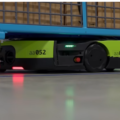Integrating robotics and 5G technology is transforming how we live, work and communicate. From advanced manufacturing to autonomous transportation and beyond, 5G networks are providing the fast and reliable connections necessary to power the latest in robotics innovation.
5G technology is the next generation of wireless networks and it is designed to provide faster speeds, lower latency and more reliable connections. This is critical for robotics, as many of the latest advancements in the field rely on real-time communication and control. For example, autonomous robots need to communicate with each other and their environment in real-time to make decisions and complete tasks effectively. The faster speeds and lower latency offered by 5G networks make this possible.
One of the key benefits of 5G technology is its ability to connect large numbers of devices at once. This is important for robotics as it allows multiple robots to work together, as well as communicate with other devices such as sensors, cameras, and even other people. This increased connectivity enables robots to operate more efficiently and effectively, which can result in increased productivity, reduced downtime and improved overall performance.
Another significant benefit of 5G technology is its ability to support mobile networks. This is important for robotics as it allows robots to be deployed in a wide range of locations and environments, such as construction sites, disaster zones and remote locations. Mobile 5G networks are ideal for these types of applications as they provide fast and reliable connectivity even in areas where traditional wired networks are not available.
In addition to its benefits for robotics, the integration of 5G technology and robotics is also expected to have a significant impact on society as a whole. For example, autonomous robots powered by 5G networks are expected to play a major role in the development of smart cities, which will rely on connected devices to manage transportation, energy and other key infrastructure. 5G and robotics are also expected to be key players in the growth of the Internet of Things (IoT), which will involve connecting billions of devices to the internet in order to collect and share data.
However, there are also some challenges associated with the integration of 5G technology and robotics. One of the main challenges is ensuring the security of these connected devices. As more and more devices become connected, the risk of cyberattacks increases. This is a major concern for robotics as many of the latest advancements in the field rely on secure and reliable communications. To address this issue, it is important to develop secure and reliable 5G networks, as well as implementing secure protocols for communication between robots and other connected devices.
In conclusion, the integration of robotics and 5G technology is transforming the way we live, work and communicate. With its fast speeds, low latency and high connectivity, 5G is powering the latest in robotics innovation, from advanced manufacturing to autonomous transportation and beyond. However, it is important to address the security challenges associated with this integration in order to ensure the safe and reliable operation of these connected devices.






